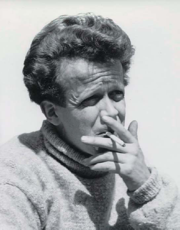
Kristian Solmer Vedel
Encyclopedia


Denmark
Denmark is a Scandinavian country in Northern Europe. The countries of Denmark and Greenland, as well as the Faroe Islands, constitute the Kingdom of Denmark . It is the southernmost of the Nordic countries, southwest of Sweden and south of Norway, and bordered to the south by Germany. Denmark...
industrial design
Industrial design
Industrial design is the use of a combination of applied art and applied science to improve the aesthetics, ergonomics, and usability of a product, but it may also be used to improve the product's marketability and production...
er and part of the Scandinavian Design
Scandinavian Design
Scandinavian design emerged in the 1950s in the three Scandinavian countries , as well as Finland. It is a design movement characterized by simple designs, minimalism, functionality, and low-cost mass production....
movement.
He completed his apprenticeship as cabinetmaker in 1942. From 1944-45 he was visiting student under professor Kaare Klint at the Department of Furniture at the Royal Academy of Fine Arts in Copenhagen. In 1946, he graduated from the Furniture Design Department of the School of Arts, Crafts and Design in Copenhagen, where he also lectured 1953-56. He served as chairman of Danish Furniture Designers 1947-49. He was instrumental in establishing the Industrial Designers of Denmark and served as the society's first chairman, from 1966 to 1968.
In 1950, he married Birgit (born Arnfred), and in 1954, they set up a design studio in Humlebæk, outside Copenhagen
Copenhagen
Copenhagen is the capital and largest city of Denmark, with an urban population of 1,199,224 and a metropolitan population of 1,930,260 . With the completion of the transnational Øresund Bridge in 2000, Copenhagen has become the centre of the increasingly integrating Øresund Region...
. The couple had four children, but were divorced in 1961. Vedel married his second wife, Ane (born Pedersen) in 1961.
Between 1968 and 1971, Kristian Vedel organised and led the Department of Industrial Design at the University of Nairobi
University of Nairobi
The University of Nairobi is the largest university in Kenya. Although its history as an educational institution goes back to 1956, it did not become an independent university until 1970 when the University of East Africa was split into three independent universities: Makerere University in...
, Kenya
Kenya
Kenya , officially known as the Republic of Kenya, is a country in East Africa that lies on the equator, with the Indian Ocean to its south-east...
. He and his wife, Ane, returned to Denmark in 1972 to establish a design studio on Thyholm
Thyholm
Until January 1, 2007 Thyholm was a municipality in the former Ringkjøbing County on the island of Vendsyssel-Thy, a part of the Jutland peninsula in northwest Denmark. The municipality included the island of Jegindø, and it covered an area of 76 km². It had a total population of 3,577...
, in North-Western Jutland
Jutland
Jutland , historically also called Cimbria, is the name of the peninsula that juts out in Northern Europe toward the rest of Scandinavia, forming the mainland part of Denmark. It has the North Sea to its west, Kattegat and Skagerrak to its north, the Baltic Sea to its east, and the Danish–German...
. At Thyholm Kristian Vedel devoted most of his time to cultivating the surrounding landscape, breeding Shropshire sheep, and researching utilization of their wool, hides and meat.
Influenced by Kaare Klint and the German Bauhaus
Bauhaus
', commonly known simply as Bauhaus, was a school in Germany that combined crafts and the fine arts, and was famous for the approach to design that it publicized and taught. It operated from 1919 to 1933. At that time the German term stood for "School of Building".The Bauhaus school was founded by...
school, his "classic modern" designs are characterized by creative use of materials, especially plastics and wood, and with a strong sense for ergonomic and functional requirements. A typical example is his children's furniture, which could be adapted to a growing child, turned over to be used as a toy. In all respects, the furniture was designed for children according to children's needs, rather than just being a miniature version of adult furniture.
In an interview, Kristian Vedel stated his position as follows:
The starting point for an industrial artist's work must always be that he, from his own point of view, and as objectively as possible, takes a position with regard to what he feels society and his fellow men need; he must personally take a stand on the existing possibilities and responsibilities.
Vedel has been awarded 1st prize by Copenhagen Cabinetmakers Guild (1947), Louisiana Museum Prize (1957), silver medal at La Triennale di Milano for children's furniture (1957), a gold medal at La Triennale di Milano for his line of stackable melamine
Melamine resin
Melamine resin or melamine formaldehyde is a hard, thermosetting plastic material made from melamine and formaldehyde by polymerization. In its butylated form, it is dissolved in n-butanol and xylene. It is then used to cross-link with alkyd, epoxy, acrylic and polyester resins, used in surface...
dishes and containers, the Design Award at Interplast in London (1961) and the Lunning Prize
Lunning Prize
The Lunning Prize was instituted by Frederik Lunning, owner of the New York agency for Georg Jensen. The prize was awarded to eminent Scandinavian designers, two each year, from 1951 to 1970...
(1962).
In January-May 2007, Trapholt Museum in Denmark mounted a retrospective exhibition of major works. As an adjunct to the exhibition, Arkitektens Forlag published a book featuring the works and drawings of Kristian Vedel.

